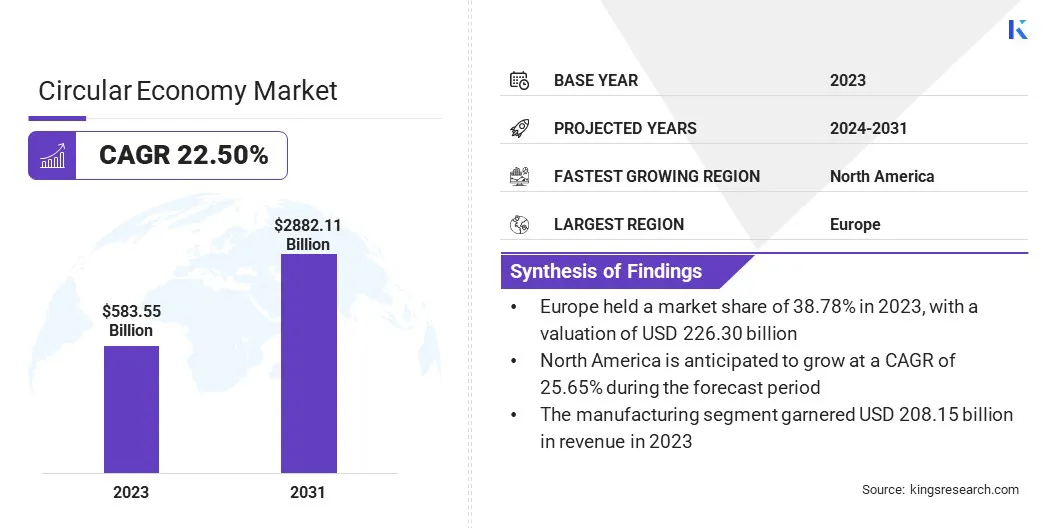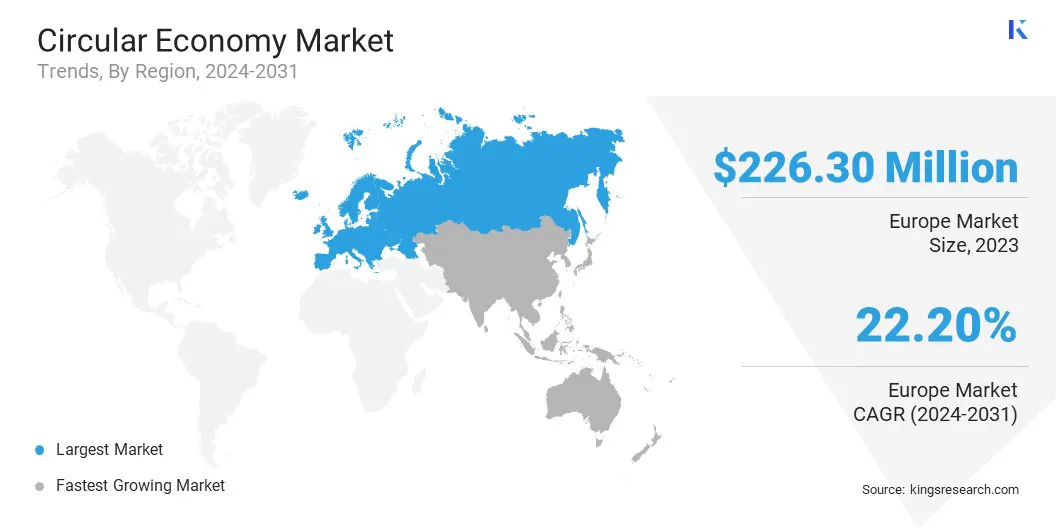Enquire Now
Circular Economy Market Size, Share, Growth & Industry Analysis, By Industry (Manufacturing, Electronics, Automotive, Packaging, Construction, Others), By Type (Recycling and Recovery, Reuse and Sharing, Product as a Service, Others), and Regional Analysis, 2024-2031
Pages: 120 | Base Year: 2023 | Release: September 2024 | Author: Ashim L.
Key strategic points
The global Circular Economy Market size was valued at USD 583.55 billion in 2023 and is projected to grow from USD 696.19 billion in 2024 to USD 2,882.11 billion by 2031, exhibiting a CAGR of 22.50% during the forecast period.
The growth of the market is driven by increasing regulatory pressure, growing consumer demand for sustainable products, ongoing technological advancements in recycling and waste management, and the financial benefits of resource optimization.
In the scope of work, the report includes solutions offered by companies such as Adidas AG, Inter IKEA Systems B.V., PepsiCo, Inc., Procter & Gamble, The Coca‑Cola Company, Unilever, ADM, BASF SE, H&M Group, HP Development Company, L.P., and others.

The expansion of the circular economy market is primarily fueled by the increasing awareness of environmental sustainability and resource scarcity.
Governments and regulatory bodies are imposing stringent policies to reduce waste, promote recycling, and minimize carbon footprints. This regulatory pressure compels industries to adopt circular models that emphasize reuse, refurbishment, and recycling of materials.
Surging consumer demand for sustainable products further augments market growth, as businesses increasingly adopt eco-friendly production methods. Technological advancements in recycling and waste management are enhancing efficiency, thereby supporting market expansion.
The financial benefits of resource optimization, including cost savings resulting from reduced raw material usage, prompt companies to adopt circular practices.
The circular economy market is witnessing substantial growth as industries transition from traditional linear models to sustainable, circular approaches. The market encompasses various sectors, including manufacturing, automotive, electronics, and packaging, each aiming to reduce environmental impact through resource-efficient practices.
Companies are increasingly investing in innovative technologies that facilitate material recovery, recycling, and product life extension.
This shift is further bolstered by government incentives and public-private partnerships that promote circular business models. Moreover, the adoption of circular principles is boosted by regulatory compliance, along with the growing recognition of economic opportunities, such as improved supply chain resilience and access to new markets.
The global market is projected to expand as businesses seek sustainable alternatives to conventional production and waste management practices.
The circular economy market represents a transformative economic system that prioritizes the continuous use of resources through the adoption of a closed-loop approach. The circular economy focuses on minimizing waste through strategies such as recycling, reuse, remanufacturing, and resource efficiency.
Key elements include designing products for durability, facilitating end-of-life recovery, and creating value from waste streams. This model promotes the redesign of supply chains to enhance sustainability, reduce environmental impact, and conserve finite resources.
In addition to recycling, it encompasses business models that emphasize sharing, leasing, and product-as-a-service solutions. The aim is to achieve a regenerative economy in which material loops are closed, and resources are continuously cycled.
Manufacturers are increasingly prioritizing circular economy practices, by focusing on product design that enhances durability, recyclability, and minimal environmental impact. Key efforts include investments in closed-loop supply chains, innovative recycling technologies, and partnerships aimed at resource recovery.
Furthermore, companies are introducing new products that incorporate recycled materials in response to the growing consumer demand for sustainable options. However, there remains a need for standardized regulations and enhanced cross-industry collaboration to effectively streamline circular practices.
It is recommended that businesses invest in digital tools such as IoT and blockchain to enhance transparency and track material flows efficiently. Highlighting the importance of consumer education regarding the benefits of circular products is likely to be crucial in fostering adoption.
A key factor boosting the growth of the market is the rising emphasis on corporate sustainability initiatives. Companies are increasingly integrating circular practices into their business strategies to meet regulatory requirements, reduce environmental impact, and enhance brand reputation.
These initiatives include designing products for recyclability, implementing take-back programs, and investing in technologies that facilitate waste reduction and resource efficiency. Additionally, businesses are recognizing the financial benefits of these practices, such as cost savings achieved through decreased material usage and lower waste management expenses.
The shift toward sustainability is further supported by investor pressure, as stakeholders favor companies that demonstrate robust environmental, social, and governance (ESG) credentials. This trend is reinforcing the transition toward circular models and contributing to market growth.
A significant challenge in the circular economy market is the lack of standardized regulations and clear guidelines across regions. The inconsistency in policies leads to confusion for businesses, thereby making it difficult to implement circular practices effectively. This regulatory fragmentation hampers cross-border operations and deters investments in sustainable technologies.
To overcome this challenge, it is essential to achieve both global and regional harmonization of circular economy standards. Governments, industry bodies, and international organizations are collaborating to develop unified frameworks that provide clear directions for companies.
Collaboration through public-private partnerships significantly advances the development of best practices and compliance tools.
By establishing consistent regulations, the market is progressing toward fostering a more predictable environment, which in turn prompts businesses to adopt circular models with greater confidence.
A prominent trend in the market is the growing adoption of digital technologies to enhance resource efficiency. Companies are increasingly leveraging data analytics, Internet of Things (IoT), and blockchain to track product lifecycles, optimize supply chains, and improve waste management.
These technologies are enabling businesses to gain real-time insights into material flows, thereby improving decision-making processes and minimizing waste generation. For instance, IoT sensors are being used to monitor the condition of products, allowing for predictive maintenance and extending their useful life.
Blockchain technology is ensuring traceability in recycling processes, thereby enhancing transparency and accountability. By integrating digital solutions, companies are streamlining operations and advancing their circular goals, thereby contributing to the growth of the market.
Another key trend in the circular economy market is the increasing emphasis on product-as-a-service (PaaS) models. Businesses are shifting from traditional ownership-based sales to service-oriented offerings, where customers are charges for the use of products rather than acquiring outright ownership.
This model is widely adopted in industries such as automotive, electronics, and furniture, where leasing, sharing, and subscription services are gaining traction. PaaS enables manufacturers to design products that are durable, repairable, and recyclable, thereby extending their lifecycle within the circular economy.
Furthermore, it allows companies to retain control over the recovery of products at the end of their lifecycle, thereby facilitating efficient recycling and reuse. The PaaS approach aligns with consumer preferences for flexible, cost-effective solutions, while also supporting sustainability goals.
The global market has been segmented based on industry, type, and geography.
Based on industry, the market has been categorized into manufacturing, electronics, automotive, packaging, construction, and others. The manufacturing segment led the circular economy market in 2023, reaching a valuation of USD 208.15 billion. This dominance is attributed to the increasing focus on sustainable production practices and regulatory compliance.
Industries are progressively adopting circular models to minimize waste, reduce raw material dependency, and improve resource efficiency. The implementation of advanced manufacturing technologies, such as 3D printing and automation, is facilitating the production of durable and recyclable products, thereby supporting circularity.
Additionally, manufacturers are investing heavily in closed-loop supply chains that emphasize material recovery and recycling, thereby augmenting the growth of the segment.
The rise in consumer demand for eco-friendly products is prompting manufacturers to innovate and adopt circular approaches. Government incentives and policies that promote sustainable manufacturing are compelling companies to shift toward circular models, thereby propelling the expansion of the segment.
Based on type, the circular economy market has been classified into recycling and recovery, reuse and sharing, product as a service, and others. The product as a service segment is poised to witness significant growth, registering a staggering a CAGR of 28.59% through the forecast period (2024-2031).
This notable expansion is fueled by a notable shift toward service-oriented business models that prioritize sustainability. Companies are increasingly offering products on a subscription or leasing basis, allowing customers to pay for usage rather than outright ownership.
This approach reduces waste by designing products for enhanced durability, repairability, and recyclability, thereby extending their lifecycle.
The PaaS model enables manufacturers to retain control over end-of-life recovery, ensuring efficient recycling and reuse. The rising consumer preference for flexible and cost-effective solutions is further boosting the demand for PaaS offerings.
Additionally, businesses are recognizing the financial benefits associated with recurring revenue streams, thereby making PaaS an attractive option.
Based on region, the global market has been classified into North America, Europe, Asia Pacific, MEA, and Latin America.

Europe circular economy market held a substantial share of around 38.78% in 2023, with a valuation of USD 226.30 billion. This dominance is reinforced by the region's strong regulatory framework and government initiatives that promote sustainability.
The European Union’s Circular Economy Action Plan sets ambitious targets for reducing waste, enhancing recycling, and improving resource efficiency.
These goals are designed to prompt businesses to adopt circular models. Companies in the region are increasingly investing in innovative technologies for recycling, product redesign, and waste management to comply with stringent environmental regulations.
Additionally, increasing consumer awareness and surging demand for sustainable products in Europe are supporting regional market growth.
Public-private partnerships and significant funding from the EU for circular economy projects are enhancing the development of sustainable infrastructure. Europe’s commitment to achieving climate goals and reducing environmental impact is reinforcing its leading position in the global market.
North America is likely to emerge as the fastest-growing region, recording a CAGR of 25.65% through the projection period. This notable growth is bolstered by the increasing adoption of sustainable business practices and technological innovations.
Companies in the region are actively investing in circular models to meet the rising consumer demand for environmentally friendly products and to comply with evolving regulations.
The transition toward reducing plastic waste and enhancing recycling infrastructure is gaining momentum, supported by government incentives and policy shifts. Technological advancements in waste management, such as AI-driven sorting systems and advanced material recovery, are further contributing to domestic market growth.
Additionally, the presence of major corporations adopting circularity and promoting sustainability within their supply chains is fostering regional market expansion. The combination of regulatory support, increased consumer awareness, and technological innovation is supporting the rapid growth of the North America market.
The global circular economy market report will provide valuable insight with an emphasis on the fragmented nature of the industry.
Prominent players are focusing on several key business strategies such as partnerships, mergers and acquisitions, product innovations, and joint ventures to expand their product portfolio and increase their market shares across different regions.
Manufacturers are adopting a range of strategic initiatives, including investments in R&D activities, the establishment of new manufacturing facilities, and supply chain optimization, to strengthen their market standing.
By Industry
By Type
By Region
Frequently Asked Questions